Your cart is currently empty!
Welcome to Westcombes - the stove and fireplace experts
Westcombes are one of London’s leading fire and stove retailers. Our showroom stocks a huge range of antique, reproduction and contemporary fires and a wide selection of gas, electric, multi-fuel and woodburning stoves in both traditional and contemporary designs.
We have knowledgeable staff who can provide invaluable information and advice and we offer a complete service from inspiration to installation.
Westcombes provide a full range of services
Blog posts
-
July 29, 2025
Wood Burning Stoves Here To Stay
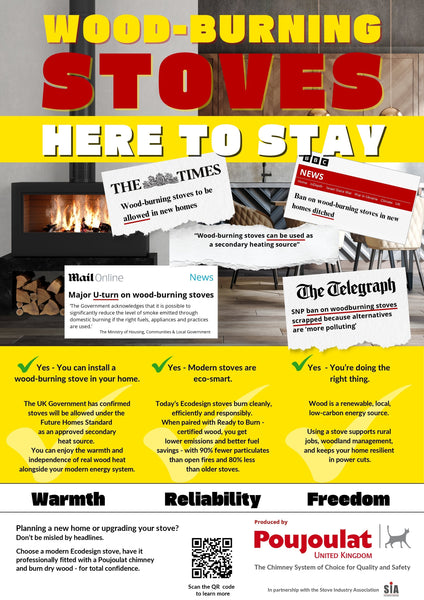
We are still supporting the ongoing efforts to tackle the misinformation around wood burning stoves.
Following the success of the "Myth Busted" campaign, the new “Here to Stay” campaign aims to reassure customers with credible, up-to-date messaging,
The highlights of the campaign include:
- The UK Government have confirmed that wood-burning stoves are not being banned
- They are approved as a secondary heat source under the Future Homes Standard
- The government recognises that when used correctly, modern stoves with dry wood produce low emissions
- Ecodesign Stoves Are Clean & Efficient, with up to 90% fewer particulates than open fires
- Up to 80% fewer emissions than older stoves
- Lower fuel costs, better performance.
- Wood is a renewable, local, low-carbon energy source
- Supports rural jobs and woodland management
- Keeps homes warm and independent during power cuts
-
February 08, 2024
Get Both Sides of the Story This Clean Night
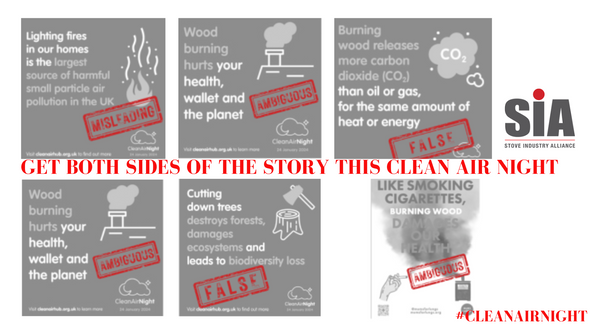
Clean Air Night 2024 (Wednesday 24th January) is being focused on what campaigners are calling the “uncomfortable truth about wood burning” and follows a prolonged period this winter where consumers have been targeted by an intense and very well-funded series of anti-burning messages by the likes of Mums for Lungs, London Wood Burning Project and Global Action Plan / Clean Air Hub.
Much of the messaging used by these groups relies on a very negative and, at times, sensationalist narrative that seeks to condemn all forms of domestic burning rather than educate users of sustainable solid fuel stoves on how best to choose and use their appliances in order to minimise emissions. A range of misleading and, in some cases, false, claims are being made which are designed to scare, not educate.
The uncomfortable truth is that these campaigns rely on flawed data and sweeping generalisations. So, this Clean Air Night we urge consumers to get both side of the story as we look at some of the anti-burning adverts you may have seen recently, shedding light on why they are misleading, ambiguous and, in some cases, untrue.


The claims made here by the London Wood Burning Project (above left) and cleanairhub.org.uk (above right) rely on the grouping of all methods of burning wood (including garden bonfires & firepits) at home. However, the data from the National Atmospheric Emissions Inventory (NAEI) shows us that burning dry wood on an Ecodesign compliant stove accounted for less than 0.1% of total UK PM2.5 emissions in 2021.
Modern stoves offer a range of benefits and you can get both sides of the story and learn more about that here.
Just like the posts above, the term ‘wood burning’ in this post (below) is deliberately ambiguous and takes no account of the type of appliance or quality of the wood fuel.
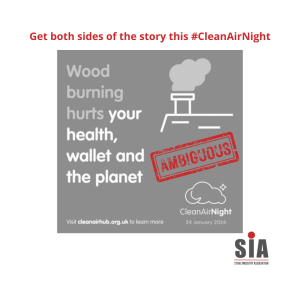
There is reliable evidence that using dry wood and other sustainable solid fuels can help consumers reduce their home heating bills. A recent study by Gemserve for Homefire found that households with gas central heating that adopt zonal heating using dry wood fuel could save up to 7% on their annual heating bill and up to 11% using smokeless solid fuel in the same way.
The same study also found that using renewable, sustainably sourced wood fuel instead of fossil fuel gas results in typical carbon savings of over half a tonne of CO2e / year.
You can read more about this study here

The claim (above) that a wood burning stove is six times more polluting than an HGV is hugely misleading.
The claim is based on a report by the European Environmental Bureau published in 2022 that looks at the amount of emissions given off by generating a GJ of heat in a stove compared to the emissions releases generating a GJ of power in an HGV.
The claims made by the study rely on a simplistic calculation using permitted rates of emission. The study also fails to factor in the non-exhaust emissions of the HGV.
What we end up with is an apples and oranges comparison that fails to consider the impact of real-world use. According to a 2020 Defra report, on average stove users light their stoves for between 3.7 and 4.5 hours a day during the winter months. An HGV can be driven by the same driver for up to 9 hours per day, and the vehicle potentially operates 24/7 up to 365 days a year.
This means that over the course of 1 week’s real-world use a Euro 6 HGV actually produces 13 times more PM2.5 (271g) than an Ecodesign stove (20.16g). You can read more on this comparison here.
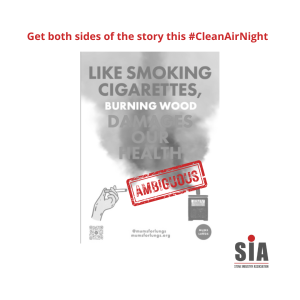
This claim (above) by campaign group Mums for Lungs is ambiguous and relies on the reader not seeking any further information on the data.
The data from the National Atmospheric Emissions Inventory (NAEI) which breaks down UK PM2.5 emissions by activity and source, shows us that in 2021 cigarette smoking accounted for 12 times more PM2.5 in the UK than burning dry wood on an Ecodesign compliant stove did.
Some of the adverts by the cleanairhub.org.uk, part of Global Action Plan, in support of Clean Air Night even contain false claims (see below).
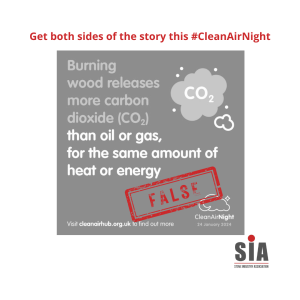
This is one example. Contrary to the information given in this post, wood logs have the lowest carbon emission factor of any domestic heating fuel at 0.01kg CO2e per kWh. That’s 1/20th the carbon emissions of natural gas or electricity, and 1/29th that of oil.
Burning dry wood is a modern, Ecodesign compliant stove is a low carbon way to heat you home and can play a key role in helping the UK to meet its net zero objectives.
You can find out more about the benefits of choosing modern stoves here.

This statement (above) is false. Woodland management is needed to ensure healthy forests and the ecosystems they support.
Wood fuel is a key component of the woodland management cycle and the economies attached to it. Using wood as fuel also plays a vital role in maintaining woodland diversity, health, and resilience. Locally sourced wood fuel helps support small businesses and reduces the carbon footprint of fuel transport.
You can learn more about the importance of woodland management here

This is another misleading statement (above) and one which is actually disproved by the findings of a recent Imperial College study which found that a “clearSkies Level 5 stove demonstrated some benefits for indoor air quality” and that “the biggest increases in PM2.5 concentrations indoors did not relate to indoor wood or solid-fuel burning but instead were a result of cooking…”.
A literature review by commissioned by the SIA and carried out by the University of Manchester found no scientific evidence for adverse health impacts from exposure to the indoor air typically associated with modern, enclosed wood burning stoves.
You can read more about this here
And lastly for something positive. We could not agree more with this post and there are significant reductions (up to 90%) possible in the emissions created by domestic burning by switching from open fires and older stoves to modern, Ecodesign compliant stoves.

The SIA encourages all solid fuel stove users to educate themselves on the importance of:
- Using the right appliance – if you use an open fire or an older stove it is time to upgrade. A modern Ecodesign compliant stove releases up to 90% less emissions than an open fire and up to 80% less than many older stoves.
- Ensuring your stove is fitted by an appropriately qualified competent person e.g. HETAS or OFTEC registered.
- Always use good quality fuel. Look for the Ready to Burn logo and never use chemically treated wood or burn waste on your stove.
- Get your stove serviced and your chimney swept at least once a year. We recommend NVQ qualified sweeps for this.
-
June 28, 2023
Answers to Questions Regarding the Myths & Misinformation About Wood Burning Stoves

At a time of multiple global crises when thousands of people have been thrown into fuel poverty, wood-burning stoves are playing a vital role in helping families survive these troubled times. So, it’s wrong and dangerous for certain newspapers to misrepresent data to blanket criticise a heat source that is helping so many.
Updating open fires and old wood-burning stoves will make a massive difference to PM2.5 emissions. However, we ask you to take a closer look at the data which reveals that modern ultra-efficient stoves are a big part of that solution.
Defra's Clean Air Strategy says domestic combustion accounts for 38% of fine particulate matter. This number was based on a government survey in 2015 which over-estimated the amount of wood being burnt on stoves and fireplaces in the UK.
A much larger, independently verified survey of over 10,000 people carried out in 2019, showed the true figure was less than a third of what the government estimated, making the domestic combustion percentage just 13%, rather than 38%. This also ignored the fact that the new Ecodesign stoves produce 66% less emissions than Defra's estimations.
The domestic combustion figure also includes outside sources including bonfires, garden incinerators, outdoor pizza ovens and even wildfires! The true contribution of wood burning stoves is therefore relatively small.
Inside The HomePM 2.5, or fine particulate matter, are microscopic particles or droplets present in the air that can be damaging to health when inhaled in sufficient quantity. The World Health Organisation (WHO) has established that the safe daily average limit for PM 2.5 in the environment should be ≤ 10 µg/m3 (1). As a point of reference, the air in Central London averages between 18-25 µg/m3.
A study conducted in the US in 2019 that featured in the Journal of Exposure Science & Environmental Epidemiology, examined 137 homes and found that the average daily level of PM 2.5 particulates in homes was 6-7 µg/m3 while those with a wood-stove was just a fraction more at 6-8 µg/m (2). A tiny difference that is well within the WHO safe level.
This doesn’t surprise us, as we know that a correctly functioning wood stove draws air, smoke and particulates out of a room and up the chimney. However, best wood-stove practices are vital in achieving these low levels and this is something that we are passionate about teaching our customers and other wood-stove users alike.
Outside The Home
Data has too often been twisted to bolster a blinkered argument. For example, comparing the emission rates between wood stoves and HGVs has caused much unnecessary concern. Claims that a wood-burning stove is worse than 750 HGVs make a good headline, but this is extremely misleading.
Closer inspection reveals that their data does not include the small particle emissions created from brake and engine wear and in fact, just one Euro 6 HGV (let alone 750) produces 13 times more PM2.5 emissions than an Ecodesign wood-burning stove over the course of a week’s real-world use. Furthermore, emissions from HGVs are emitted at ground level (nearer head height), whereas wood smoke is dispersed more safely, higher up via a chimney flue.
The SIA say,
"The claims are based on simplistic calculations using permitted rates of emission and do not consider either real world use or non-exhaust emissions. Furthermore, these permitted emissions rates rely on vastly differing measurement protocols and techniques. It should also be noted that there are several unreferenced assumptions, and the report does not appear to have been independently peer reviewed. "
Not all wood burning is the same
Another common error is to lump in modern efficient stoves with all other forms of domestic wood-burning, including open fires and outdoor bonfires which are far more polluting. However, a high-quality ClearSkies rated stove that is properly installed and serviced and is burning properly seasoned wood fuel, actually reduces emissions by up to 90% compared with an open fire and up to 80% compared with a 10 year old stove.
Additionally, logs that are sourced from properly managed woodland can be a sustainable practice that works in harmony with our forests. In fact, copsing is key for wildlife proliferation and the future of our woodlands.
When the UK government released its 2020 figures for PM emissions the data showed that the overall percentage of PM2.5 attributable to domestic indoor burning (including open fires and old stoves) was 17%. More importantly, it showed that modern Ecodesign compliant wood burning stoves were contributing just a tiny 1-2% to emissions.
Trusted Chief Medical Advisor Chris Whitty in his latest report acknowledges this saying, “For air pollution emissions, there is substantial difference between the different open fire and stove designs, the age of the appliance and how well maintained it is, and the moisture content of the wood, for those who want to burn wood.”
Therefore, a far more pragmatic and impactful approach to reducing PM 2.5 levels would be to target the significant percentage from open fires and old stoves by actively encouraging people to switch to modern Ecodesign ClearSkies rated wood-burning stoves and educating them on the importance of using the right fuel.
- June 10, 2021 The Best Time to Fit a Stove is Spring & Summer Time











